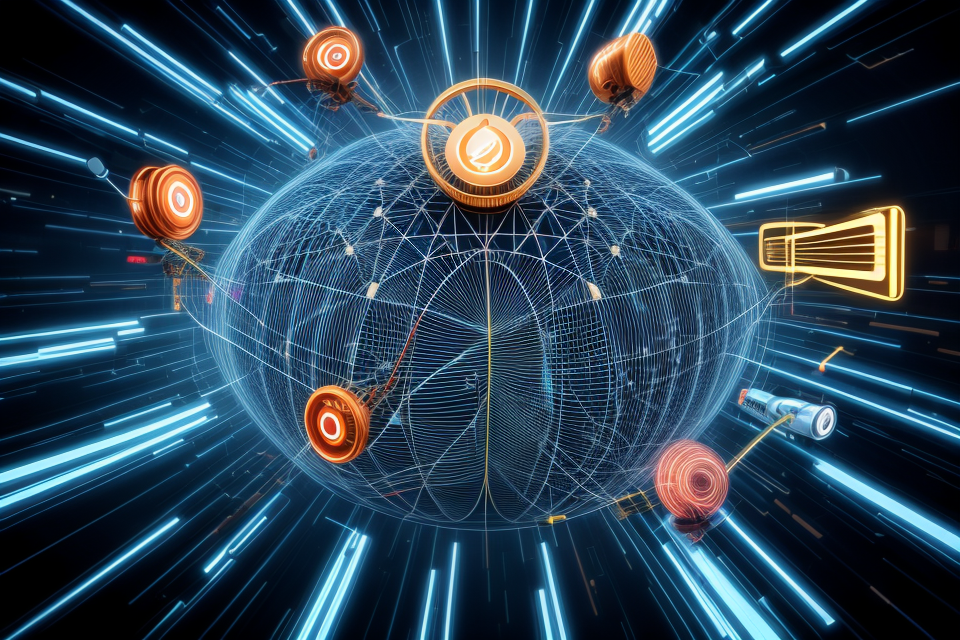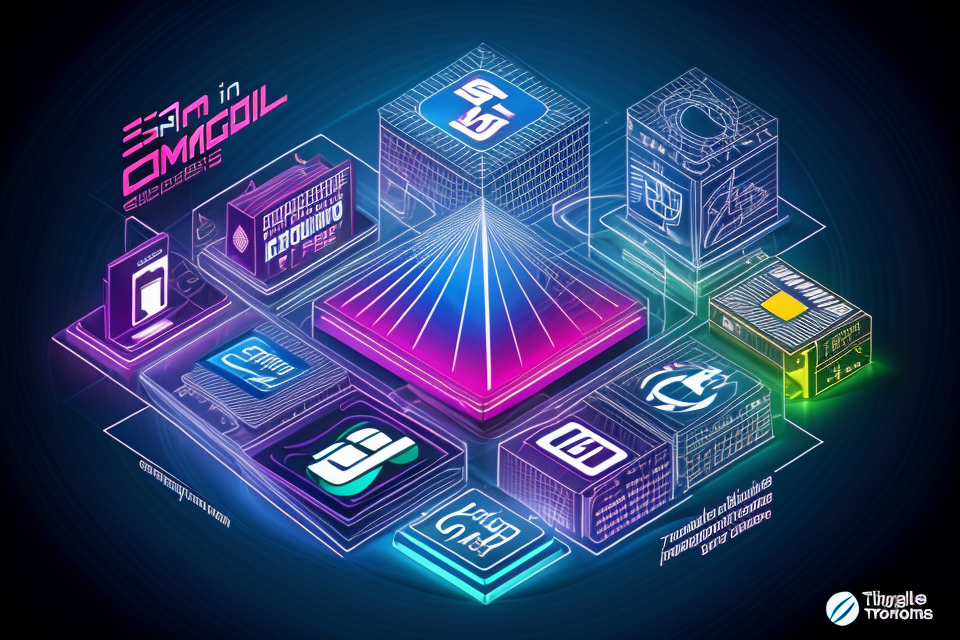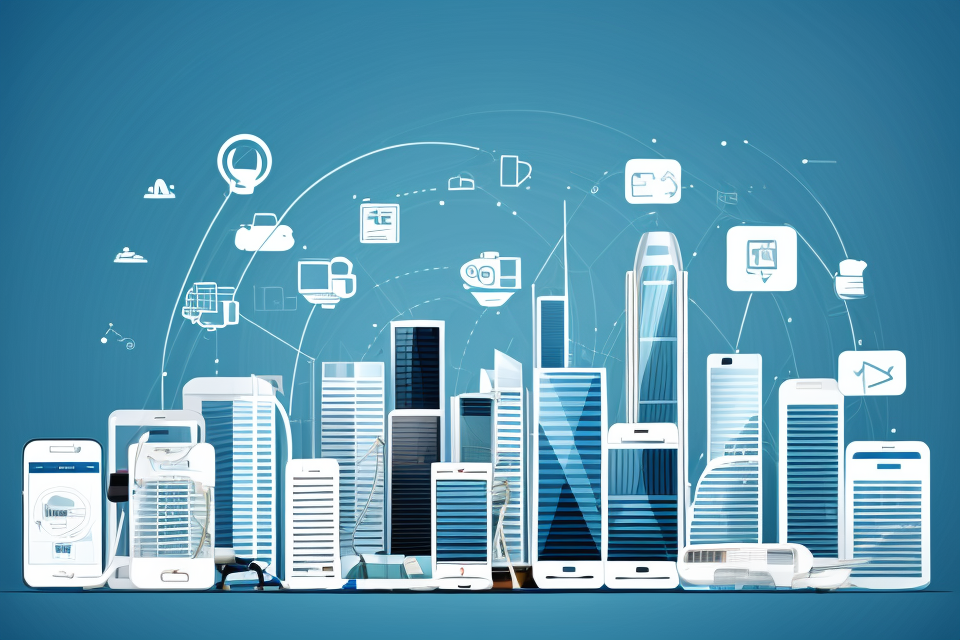
Telecommunications have revolutionized the way we communicate, work, and live our lives. It has connected the world like never before, breaking down barriers of distance, time, and culture. From the invention of the telegraph to the rise of the internet, telecommunications have been a driving force behind the globalization of business, education, and entertainment. In this article, we will explore the transformative impact of telecommunications on modern society, examining its effects on our daily lives, our economy, and our culture. We will also look at the challenges and opportunities that telecommunications present, and how they are shaping the future of our world.
The Emergence of Telecommunications: A Brief Overview
The Evolution of Telecommunications: From Telegraph to Internet
The evolution of telecommunications has been a gradual process, with each new technology building upon the foundation laid by its predecessor. From the telegraph to the internet, telecommunications have transformed the way people communicate, access information, and conduct business. In this section, we will take a closer look at the evolution of telecommunications from the telegraph to the internet.
Telegraph: The First Step Towards Global Communication
The telegraph, invented by Samuel Morse in 1837, was the first electronic means of communication. It revolutionized long-distance communication by transmitting messages over a telegraph line using a code of dots and dashes. The telegraph enabled people to communicate instantaneously over long distances, paving the way for global communication. It played a crucial role in events such as the American Civil War, where it was used to coordinate military operations and share intelligence.
Telephone: Voice Communication at the Speed of Light
The invention of the telephone by Alexander Graham Bell in 1876 marked another significant milestone in the evolution of telecommunications. The telephone enabled people to communicate via voice over long distances, revolutionizing the way people communicate. It enabled individuals and businesses to communicate instantly, regardless of their location. The telephone also facilitated the growth of telephone networks, which eventually led to the development of the public switched telephone network (PSTN).
Radio: Bridging the Gap Between Local and Global
The invention of the radio by Guglielmo Marconi in 1895 marked the beginning of wireless communication. The radio enabled people to receive and transmit information wirelessly, making it possible to bridge the gap between local and global communication. It played a crucial role in events such as World War II, where it was used for military communication and propaganda. The radio also paved the way for the development of other wireless technologies, such as television and satellite communication.
Television: Visualizing the World
The invention of television by John Logie Baird in 1926 marked another significant milestone in the evolution of telecommunications. Television enabled people to visualize events and information from around the world, making it possible to bring distant events into people’s homes. It played a crucial role in events such as the Apollo moon landings, where it was used to broadcast live footage of the astronauts on the moon.
Internet: The Game-Changer in Global Communication
The invention of the internet by Vint Cerf and Robert Kahn in 1983 marked the beginning of the modern era of telecommunications. The internet enabled people to communicate, access information, and conduct business online, revolutionizing the way people communicate and access information. It has enabled people to connect with others from around the world, access a wealth of information, and conduct business online. The internet has also facilitated the development of other technologies, such as social media, e-commerce, and cloud computing.
In conclusion, the evolution of telecommunications has been a gradual process, with each new technology building upon the foundation laid by its predecessor. From the telegraph to the internet, telecommunications have transformed the way people communicate, access information, and conduct business. Each technology has played a crucial role in shaping the world as we know it today, and has paved the way for the development of other technologies.
The Significance of Telecommunications in Shaping Modern Society
Fostering Global Connectivity
- The invention of the telegraph in the 19th century marked the beginning of modern telecommunications.
- Since then, the development of telecommunications technologies has facilitated seamless communication across borders, breaking down geographical barriers and enabling people to connect with others from different parts of the world.
- The proliferation of the internet and mobile devices has further expanded global connectivity, enabling instant communication and collaboration across time zones and continents.
Facilitating the Exchange of Ideas and Information
- Telecommunications have revolutionized the way ideas and information are shared and disseminated.
- The widespread use of the internet and social media has enabled people to access vast amounts of information at their fingertips, breaking down traditional gatekeepers and promoting democratization of knowledge.
- Telecommunications have also facilitated the emergence of new forms of media, such as blogs, podcasts, and online publications, providing alternative platforms for individuals and groups to share their perspectives and ideas.
Promoting Cultural Diversity and Understanding
- Telecommunications have played a significant role in promoting cultural diversity and understanding by enabling people to access and engage with different cultures.
- The internet has provided a platform for people to share their cultural practices, traditions, and values with others, fostering greater understanding and appreciation of cultural differences.
- Telecommunications have also enabled people to connect with others from different cultural backgrounds, breaking down stereotypes and promoting empathy and respect.
Driving Economic Growth and Innovation
- Telecommunications have been a key driver of economic growth and innovation by enabling new forms of commerce and facilitating the exchange of goods and services.
- The rise of e-commerce and online marketplaces has transformed the way businesses operate, providing new opportunities for entrepreneurs and small businesses to reach global markets.
- Telecommunications have also fostered innovation by enabling collaboration and knowledge sharing among individuals and organizations, leading to the development of new products, services, and technologies.
The Technological Advancements That Revolutionized Telecommunications
From Analog to Digital: The Technological Leap
The shift from analog to digital technology has been a significant turning point in the history of telecommunications. This transition has revolutionized the way we communicate, process information, and access data. Here are some key aspects of this technological leap:
The Emergence of Digital Signals
The move from analog to digital technology has been driven by the need for more efficient and reliable communication systems. Digital signals, which represent data as a series of ones and zeros, have several advantages over analog signals. They can be transmitted over longer distances without losing quality, are less susceptible to interference, and can be easily compressed, allowing for more efficient data storage and transmission.
The Birth of the Internet
The advent of digital technology has also given rise to the Internet, a global network that has revolutionized the way we communicate and access information. The Internet has enabled the rapid exchange of data between computers, leading to the development of new technologies and services such as email, social media, and online shopping. Today, the Internet is an integral part of modern society, and its impact can be seen in virtually every aspect of our lives.
The Growth of Mobile Communications
The shift to digital technology has also facilitated the growth of mobile communications. Mobile devices, such as smartphones and tablets, have become ubiquitous, providing users with instant access to information and communication tools. The widespread adoption of mobile devices has transformed the way we live, work, and socialize, enabling us to stay connected no matter where we are.
The Transformation of Broadcasting
Finally, the move to digital technology has also transformed the world of broadcasting. Digital television, radio, and other media offer higher-quality signals, more channels, and greater interactivity than their analog counterparts. Digital broadcasting has enabled the creation of new services, such as streaming platforms and catch-up TV, which have further revolutionized the way we consume media.
In conclusion, the transition from analog to digital technology has had a profound impact on telecommunications and modern society. This technological leap has enabled the development of new technologies, services, and ways of communicating, transforming the way we live, work, and interact with each other.
The Impact of Telecommunications on Our Daily Lives
Communication: The Heart of Modern Society
In the era of telecommunications, the way we communicate has drastically changed. The traditional methods of communication, such as letters and phone calls, have been replaced by instant messaging, video calls, and social media platforms. This shift has made communication faster, more convenient, and more accessible. With just a few taps on our smartphones, we can connect with people from all around the world, breaking down geographical barriers and bringing us closer together.
Entertainment: Bringing the World to Our Fingertips
Telecommunications have transformed the way we access and consume entertainment. Gone are the days of waiting for a movie or a TV show to air on television. With streaming services, we can watch our favorite shows and movies at any time, anywhere. The rise of social media platforms has also made it easier for artists to share their work with a global audience, making entertainment more diverse and inclusive.
Education: Democratizing Knowledge and Opportunities
Telecommunications have had a profound impact on education, making knowledge more accessible and democratizing opportunities for learning. Online courses and educational resources have made it possible for people to learn new skills and acquire knowledge from anywhere in the world. This has particularly benefited those in remote or underserved areas, giving them access to quality education that they may not have had otherwise.
Commerce: Connecting Markets and Creating Global Economies
Telecommunications have revolutionized commerce, connecting markets and creating global economies. E-commerce has made it possible for businesses to reach customers worldwide, expanding their customer base and increasing revenue. Online marketplaces have also made it easier for small businesses and entrepreneurs to compete with larger corporations, leveling the playing field and promoting economic growth.
In conclusion, telecommunications have had a transformative impact on our daily lives, changing the way we communicate, access entertainment, learn, and do business. As technology continues to advance, it is likely that telecommunications will continue to play a vital role in shaping our society and transforming the way we live.
The Dark Side of Telecommunications: Challenges and Drawbacks
Cybersecurity Threats and the Vulnerability of Information
- The rapid advancement of telecommunications has led to a world where information is more accessible than ever before. However, this increased connectivity has also given rise to new cybersecurity threats that have made the vulnerability of information a pressing concern.
- Hacking and cybercrime have become prevalent in the digital world, with cybercriminals exploiting the weaknesses in communication systems to steal sensitive information or disrupt operations. The growing sophistication of these attacks has made it increasingly difficult for individuals and organizations to protect themselves against these threats.
- One of the most significant challenges posed by cybersecurity threats is the potential for severe financial losses. Cybercrime can result in significant financial losses for both individuals and organizations, as the costs of recovery and the potential damage to reputation can be substantial.
- In addition to financial losses, cybersecurity threats can also have a broader impact on society. For example, cyberattacks on critical infrastructure, such as power grids and transportation systems, can disrupt daily life and have serious consequences for public safety.
- The rise of cybersecurity threats has also led to increased privacy concerns, as individuals and organizations struggle to balance the need for security with the desire for personal freedom. As more information is stored digitally, the risk of unauthorized access and data breaches has become a significant concern.
- The issue of disinformation and media manipulation has also emerged as a major challenge in the digital age. The ease with which false information can be spread has led to an erosion of trust in the media and a rise in fake news, which can have serious consequences for democracy and social cohesion.
In conclusion, the transformative impact of telecommunications on modern society has been significant, but it has also given rise to new challenges and drawbacks. Cybersecurity threats and the vulnerability of information are among the most pressing concerns, and it is essential for individuals and organizations to take steps to protect themselves against these threats. By addressing these challenges, it is possible to harness the power of telecommunications to drive positive change and improve the quality of life for all.
The Digital Divide: Inequality in Access to Telecommunications
The rapid advancement of telecommunications technology has brought about unprecedented opportunities for connectivity and communication. However, the benefits of this technological revolution have not been evenly distributed across society. In fact, the digital divide, which refers to the unequal distribution of access to telecommunications technology, has emerged as a significant challenge in modern society.
The Global North-South Divide: The Geography of Connectivity
The global north-south divide is a geographical representation of the digital divide. This divide is largely attributed to the historical legacy of colonialism and neocolonialism, which has led to the uneven distribution of resources and infrastructure across the world. As a result, developed countries in the global north have access to advanced telecommunications infrastructure, while developing countries in the global south lag behind.
The Urban-Rural Divide: The Infrastructure of Inequality
Another dimension of the digital divide is the urban-rural divide. Urban areas typically have better telecommunications infrastructure than rural areas, which can lead to a lack of access to information and communication technology in rural regions. This infrastructure gap is often caused by the high cost of building and maintaining telecommunications infrastructure in rural areas, which can be difficult due to challenging terrain and low population density.
The Income Divide: Access to Information as a Luxury Good
Finally, the digital divide is also influenced by income inequality. Access to telecommunications technology is often seen as a luxury good, and low-income individuals may not be able to afford the cost of accessing these technologies. This can result in a significant disparity in access to information and communication technology between high-income and low-income individuals.
Overall, the digital divide represents a significant challenge to the transformative impact of telecommunications on modern society. The unequal distribution of access to telecommunications technology can perpetuate existing social inequalities and hinder efforts to create a more equitable and connected world.
The Future of Telecommunications: Trends and Predictions
5G and Beyond: The Next Generation of Wireless Communications
Enhanced Speed and Capacity: A New Era of Connectivity
As technology continues to advance, the demand for faster and more reliable wireless communication has grown exponentially. The fifth-generation (5G) cellular network represents a significant leap forward in meeting this demand. 5G is designed to offer higher data rates, lower latency, and increased network capacity compared to its predecessors. With peak download speeds of up to 20 Gbps, 5G networks promise to revolutionize the way we connect and communicate, enabling applications such as virtual reality, augmented reality, and the Internet of Things (IoT).
One of the primary benefits of 5G is its increased capacity for handling a massive number of connected devices. This is due to the use of millimeter waves, which provide more bandwidth and can support a larger number of simultaneous connections. This is particularly important for IoT applications, which require vast networks of interconnected devices to function effectively. With 5G, it is now possible to connect billions of devices simultaneously, enabling new use cases such as smart cities, autonomous vehicles, and remote healthcare.
The Internet of Things: Increasing Interconnectedness
The IoT is a network of physical devices, vehicles, buildings, and other items embedded with electronics, software, sensors, and network connectivity that enables these objects to collect and exchange data. The IoT has the potential to transform many aspects of modern society, from transportation and healthcare to energy management and urban planning. With 5G, the IoT can finally realize its full potential by providing the necessary bandwidth and low latency required for real-time data transmission and processing.
For example, in the healthcare sector, 5G-enabled wearable devices can monitor patients’ vital signs in real-time, alerting healthcare professionals to potential issues before they become serious. In the manufacturing industry, 5G-connected devices can optimize production processes, reduce downtime, and improve overall efficiency. As more devices are connected to the IoT, the potential applications and benefits are virtually limitless.
Edge Computing: Reducing Latency and Improving User Experience
Edge computing is a distributed computing paradigm that brings computation and storage closer to the devices and applications that need them, rather than centralizing them in a data center or the cloud. By processing data at the “edge” of the network, close to the source of the data, edge computing can reduce latency and improve user experience, particularly in applications that require real-time responses, such as autonomous vehicles and remote surgery.
With 5G, edge computing can be implemented more effectively, as the low latency and high bandwidth of the network enable faster data transmission and processing. This, in turn, allows for more efficient use of network resources and reduces the need for expensive cloud computing infrastructure. As a result, edge computing is becoming an increasingly important aspect of 5G networks, as it offers the potential to unlock new use cases and improve the overall user experience.
Artificial Intelligence and Machine Learning: The Future of Telecommunications
Enhancing Network Efficiency and Performance
- Predictive maintenance through anomaly detection
- Optimization of network resources through dynamic allocation
- Real-time monitoring and analysis of network performance
Personalized Content and Targeted Advertising
- Content recommendation systems based on user preferences
- Personalized advertising using user data for targeting
- Enhanced user experience through customized content delivery
Privacy Concerns and the Ethics of AI in Telecommunications
- Ensuring data privacy and security in telecommunications networks
- Addressing ethical concerns in the use of AI for personalized content and advertising
- Developing policies and regulations to govern the use of AI in telecommunications.
Space-Based Telecommunications: The Final Frontier
The Potential of Satellite Constellations for Global Connectivity
In recent years, the concept of satellite constellations has gained significant traction as a means of providing global connectivity. A satellite constellation is a group of artificial satellites working together to provide enhanced coverage and communication capabilities. These constellations are designed to provide reliable and uninterrupted connectivity to remote and underserved areas, as well as to support emerging technologies such as the Internet of Things (IoT) and 5G networks.
One of the primary advantages of satellite constellations is their ability to provide coverage to areas that are not easily accessible by traditional means. This includes remote regions, such as the poles, oceans, and deserts, as well as regions with limited infrastructure or political instability. By leveraging the power of satellite technology, these areas can be connected to the global network, enabling new opportunities for economic growth, education, and innovation.
The Future of Space Exploration and Communication
As space exploration continues to advance, the role of telecommunications in supporting these efforts will become increasingly important. Future space missions, such as manned missions to Mars, will require reliable and robust communication systems to maintain contact with Earth. Satellite constellations will play a critical role in enabling real-time communication between astronauts and mission control, as well as providing crucial data and information for scientific research.
In addition to supporting space exploration, satellite constellations will also play a vital role in the development of future space-based technologies, such as satellite-based transportation systems and space tourism. As these technologies mature, the demand for reliable and high-speed communication systems will increase, further driving the development of satellite constellations.
Ethical and Legal Considerations for Space-Based Telecommunications
As with any new technology, the development and deployment of satellite constellations raise a number of ethical and legal considerations. These include concerns over space debris, the potential for interference with other satellites, and the impact on the environment. Additionally, there are questions around the ownership and governance of space, as well as the responsibility for maintaining and regulating space-based infrastructure.
As the use of satellite constellations continues to grow, it will be essential to address these concerns through international cooperation and the development of clear guidelines and regulations. This will ensure that the benefits of space-based telecommunications can be realized while minimizing potential risks and negative impacts.
FAQs
1. What is telecommunications?
Telecommunications refers to the transmission of information and communication over long distances through various mediums such as telephone, internet, radio, television, and other forms of electronic communication. It allows people to communicate and exchange information across vast distances in real-time.
2. How has telecommunications transformed modern society?
Telecommunications has revolutionized modern society by connecting people across the globe, enabling them to communicate, share ideas, and conduct business with ease. It has also enabled access to vast amounts of information and has facilitated globalization. The ability to communicate instantaneously has changed the way people live, work, and interact with each other.
3. What are some examples of telecommunications technologies?
Some examples of telecommunications technologies include telephones, the internet, mobile phones, satellite communication, and television. These technologies have greatly impacted modern society by allowing people to communicate and access information in ways that were previously impossible.
4. How has telecommunications impacted the economy?
Telecommunications has had a significant impact on the economy by enabling businesses to operate on a global scale. It has also facilitated the growth of e-commerce and has allowed people to work remotely. Additionally, telecommunications has enabled the sharing of information and ideas, leading to innovation and economic growth.
5. What are some challenges associated with telecommunications?
One challenge associated with telecommunications is the digital divide, which refers to the gap between those who have access to technology and those who do not. Additionally, there are concerns about privacy and security when using telecommunications technologies. Finally, there is the issue of cyberbullying and online harassment, which can have negative impacts on individuals and society as a whole.


